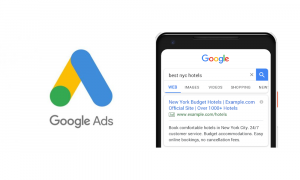
Google Responsive Search Ads
Google Ads has just completed beta for their newest ad unit for search advertisers: Responsive Search Ads.
Responsive search ads allow advertisers to enter multiple combinations of headlines and descriptions which Google’s machine learning will then test and optimize for the best performing combination.
Here are how the new responsive search ads work, their potential advantages, and some best practices outlined from Google’s Responsive Search Ads support page.
What Are Responsive Search Ads?
Responsive search ads are a text ads that allow advertisers to enter multiple headlines and descriptions which Google’s machine learning will then test, learn, and optimize for the best performing combination according to search query.
This can help advertisers create ads that are more relevant to their ideal customers’ searches.

Responsive search ads let you create an ad that adapts to show more text—and more relevant messages—to your customers. Enter multiple headlines and descriptions when creating a responsive search ad, and over time, Google Ads will automatically test different combinations and learn which combinations perform best. By adapting your ad’s content to more closely match potential customers’ search terms, responsive search ads may improve your campaign’s performance.
The more headlines and descriptions entered, the more Google Ads can test and then learn which combinations work best with different search queries.
The Advantages of the New Responsive Search Ads
The new responsive search ads are the latest example of Google’s advances in machine learning and automation.
1. Optimization through machine learning
These new ad units will allow advertisers to input up to 15 different headlines and 4 descriptions.
Google will then test and run all possible combinations to create the best performing configuration.
No more A/B testing — Google’s AI will now autonomously test all possible outcomes which save advertisers valuable time.
2. Show more text and relevant messages to customers
These ads can feature 3 headlines and two 90-character descriptions.
You can also specify their width, giving more space to show on mobile. This will improve the visibility of your search ads on mobile devices.
3. Show up in more relevant searches
By using multiple combinations of headlines and descriptions, your ads will have the opportunity to compete in more auctions.
This will help your message reach more customers by showing up for more searches.
“Showing an optimized search ad with the right message to the right audience has the potential to boost the CTR and lower CPCs for Search campaigns,” says Brisco.
“If done correctly, this can help advertisers improve their ROAS and reduce wasted ad spend.”
“So far we’ve seen mixed results for different campaigns, so it’s still too early to make a ruling on this feature.”
6 Tips for Using Responsive Search Ads
Google has outlined some best practices for advertisers to consider to get the most out of the new responsive search ads:
1. Provide at least 8-10 headlines. The more headlines you provide, the more options there are to assemble your messages into relevant ads, which may increase performance.
2. Include a keyword in 2 headlines.
3. Include at least another 3 headlines that do NOT include your keywords.
4. Highlight additional products or service benefits and features, a problem you’re solving, or highlight shipping and return information.
5. Create headlines of different lengths. Don’t try to maximize the character count in every headline.
6. Add at least 2 distinct descriptions. Responsive search ads could show up to two descriptions at a time.



